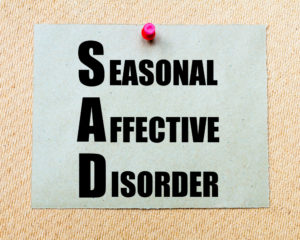For some, fall is a time to look forward to – pumpkin spice lattes, oversized sweaters, and changing leaves all have a certain appeal to people who love fall. For others, fall means the beginning of seasonal affective disorder (SAD). Fewer hours of sunlight and cooler weather contribute to depression-like symptoms for an estimated 5% of adults.
Recognizing symptoms of SAD can help you get treatment sooner so you can feel better throughout the fall and winter months.

What Are Some Symptoms of Seasonal Affective Disorder (SAD)
While SAD can affect people both in the fall and spring, the majority of people who experience this disorder do so in the fall. Most experts believe that lack of sunlight is the main culprit behind SAD. Since it’s harder for people to spend time outdoors in the fall and winter months, they get less vitamin D and fresh air.
All of this can contribute to depression-like symptoms, including:
- Fatigue or low energy
- Sadness or irritability
- Difficulty thinking, concentrating, or making decisions
- Feelings of hopelessness
- Changes in weight
- Changes in sleep patterns
- Loss of interest in social activities
The primary difference between depression and SAD is that depression is a year-round condition while SAD usually only lasts for about 40% of the year. If you notice any of the above symptoms occurring seasonally, you may be experiencing SAD.
Diagnosing and Treating SAD
The good news is that you don’t have to continue to be miserable throughout the darker months. SAD is both diagnosable and treatable. The best way to get a diagnosis for your symptoms is to make an appointment with your therapist to discuss the issue.
Your therapist will take a full mental health history to make sure that you are properly diagnosed so you can receive the treatment that you need. Once you have a diagnosis, there are a few things that you can do to begin managing this disorder.
Light Therapy
If sunlight is unavailable, a therapist may recommend exposure to specialized lightboxes. The beauty of this type of therapy is that you can do it while working, reading, or just sitting at home. As long as the light enters your eyes indirectly, light therapy has been proven effective.
Behavioral Therapy
Cognitive-behavioral therapy (CBT) is a commonly used type of therapy that helps people to challenge their beliefs about their beliefs or environment. Participating in this type of talk therapy may help you see the seasons differently or work through thought patterns and/or behaviors that influence the way you experience fall and winter months.
Medication Management
Taking antidepressants along with therapy participation can help you level out the chemicals in your brain that lead to SAD. A medication management expert will work with you to choose the correct medication for your needs and ensure that it doesn’t cause poor interactions with any other medications you’re already taking.
Get Help for Your Seasonal Affective Disorder (SAD)
Reaching out for help is the first step to feeling better. GBCC offers an affirmative and caring environment for individuals of all ages to begin feeling better. Give us a call today at 410.760.9079 or contact us online for more information.
